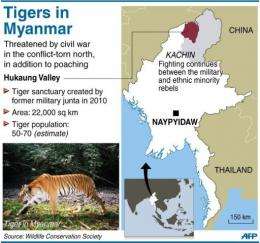Civil war endangers Myanmar's ailing tigers

Efforts to stop Myanmar's tigers being hunted to extinction are under threat from a civil war raging in a region home to the world's biggest sanctuary for the endangered cats, experts warn.
The former junta in 2010 expanded the tiger reserve to about 8,450 square miles (22,000 square kilometres) -- an area roughly the size of Israel -- in the remote Hukaung Valley, where about 50-70 tigers are estimated to remain.
But fighting over the past year between the military and ethnic minority rebels has hindered efforts to prevent the animals from being wiped out in one of Southeast Asia's last frontiers for wildlife conservation.
While most of the clashes are further east near the border with China, the rebel Kachin Independence Army (KIA) controls part of the Hukaung Valley, one of the world's richest biodiversity areas but for now off limits to foreigners.
Although the KIA supported the creation of the reserve, it is considered too risky for guards to venture deep into the forest because of the conflict, which has displaced tens of thousands of people in Kachin state.
"It's very difficult to patrol actively right now," said Robert Tizard, an expert in Yangon with the New York-based Wildlife Conservation Society, which works with the Myanmar government to train rangers in the reserve.
"Our guys wear camouflage fatigues and have a lot of equipment like the army or the KIA, so if one of our teams came across one of the armed groups and nobody knew what was going on the chance for an accident is pretty high."
Conservationists say the valley has the potential to hold several hundred tigers, but rebuilding the population requires tackling illegal hunting of both the animals -- whose body parts are prized for Chinese medicines -- and their prey.
"The tigers are in terrible shape," said Alan Rabinowitz, chief executive of wild cat protection group Panthera who helped to create the reserve but now fears the tiger population there is in rapid decline.

"The tiger is still valuable and the indigenous people there such as the Lisu and the Kachin are very much tied into the Chinese trade, and they've been killing off tigers," he told AFP by telephone from the United States.
"I'm not convinced frankly that we're going to be able to save the tigers there. We're going to try because it's a big enough area and we know there are still tigers in some of the more remote regions in the far north," he added.
A lack of funds has been another problem, although a recent easing of Western sanctions has raised hopes that more money will become available to pay for the patrols needed for such a big area, the expert said.
"You need law enforcement, protection and guards -- that's the number one thing," added Rabinowitz, who led the first ever biological expedition in the area in 1999.
As many as 100,000 tigers prowled Asia's forests and grasslands a century ago, but numbers have slumped mainly because of poaching and loss of habitat. Worldwide the wild tiger population is thought to have fallen as low as 3,000.
The Indochinese tiger (Panthera tigris corbetti), the type found in Myanmar, Thailand, Laos, Vietnam, Cambodia and southwest China, is close to critically endangered status, according to the International Union for Conservation of Nature.
The Hukaung Valley is said to be one of the region's last closed forests -- an area with dense tree cover -- and there are hopes the reserve could also protect other large mammals such as clouded leopards and Asian elephants.
Myanmar's government says it is committed to trying to save the tigers and is recruiting staff to protect the reserve. It says surprise checks on local markets are also deterring the sale of wild animal meat.
"Sanctuary staff, the Tiger Conservation Police Force and Wildlife Conservation Society are working together in restricting and taking action on hunting and penetrating into the area," the Nature and Wildlife Conservation Division said in a statement to AFP.
By hiring indigenous peoples as guards, it is hoped that local communities will grow to learn about the importance of saving the big cats.
But their value means locals are not the only ones hunting the animals -- poachers are also believed to come from elsewhere in the region.
"You're talking tens of thousands of dollars at this point for a tiger and it's very specialised work because there are so few of them and they're so hard to track down," said Tizard.
Despite the huge challenges, conservationists remain hopeful that if and when fighting ends in northern Myanmar, the tigers in the Hukaung Valley will be left in peace.
"They're big pussy cats. They breed -- if you give them enough to eat, and if you stop people coming in trying to target them," said Colin Poole, director for the WCS in Asia.
"It's a big chunk of habitat perfect for tigers. They need to just be allowed space. But that's not going to happen until there's some level of peace there and security."
(c) 2012 AFP

















